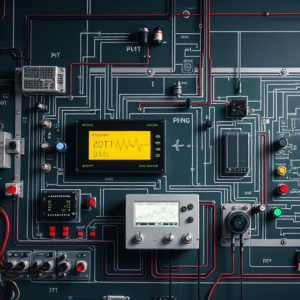A Control System is a system that manages, directs, or regulates the behavior of other devices or systems. control systems help us manage and control how things behave. Whether it’s your air conditioner, a robot, or an airplane, control systems ensure that everything works smoothly and as expected by continuously monitoring and adjusting based on feedback. Control systems are key to making sure that everything from household devices to industrial machines operates correctly, efficiently, and safely. Control systems are all about regulating and managing the behavior of systems. By using tools like feedback, compensators, and controllers (like PID), we can make systems more stable, accurate, and efficient. Key concepts include:

What is a Control System ?
Think of a control system like a thermostat in your house.
- The thermostat controls your heating system to maintain the right temperature.
- If the temperature drops too much, the thermostat tells the heater to turn on.
- If the temperature gets too high, it tells the heater to turn off.
The thermostat is like the “controller”, and the heating system is the “system” being controlled.
Types of Control Systems :
There are two main types of control systems:
Open-Loop System:
- This system does not use feedback. It works based on an input without checking if it achieves the desired output.
- Example: A washing machine that runs for a set time, regardless of whether the clothes are clean.
Closed-Loop System:
- This system uses feedback. It measures the output and adjusts the input to make sure the desired result is achieved.
- Example: A thermostat in your house, which adjusts the heating system based on the temperature in the room.
Components of a Control System :
A control system has a few key components:
- Controller: This is like the “brain” of the system. It decides what action to take.
- Example: The thermostat decides whether to turn the heater on or off.
- System (Plant): This is the part of the system that is being controlled.
- Example: The heater in your house.
- Feedback: This is the information about the system’s output that goes back to the controller, so it can adjust the system’s behavior.
- Example: The temperature in the room that the thermostat checks.
Why Use Control Systems :
Control systems help us maintain stability, improve performance, and achieve desired outcomes. Without control systems, things would be chaotic. For example:
- Airplanes use control systems to maintain a steady flight.
- Cars use control systems to manage speed and fuel.
- Factory machines use control systems to produce products with high efficiency and accuracy.
Feedback in Control Systems :
Feedback is very important in control systems. It tells the system whether it’s doing what it’s supposed to do. There are two types of feedback:
- Positive Feedback: Increases the input based on the output (it makes the system more extreme).
- Example: A microphone near a speaker can cause loud feedback noise because the microphone picks up sound from the speaker and amplifies it more and more.
- Negative Feedback: Reduces or corrects the input based on the output (it helps stabilize the system).
- Example: A thermostat that turns off the heater once the room reaches the desired temperature.
PID Controllers (Proportional-Integral-Derivative) :
In many control systems, we use something called a PID controller to adjust the system:
- P (Proportional): It looks at the current error and makes changes based on that. If the temperature is off by 5 degrees, it makes a big change.
- I (Integral): It looks at past errors and helps correct them over time. If the temperature has been slightly off for a while, it will adjust to fix it.
- D (Derivative): It looks at how fast the error is changing and tries to reduce that rate of change. This prevents the system from overshooting the target (for example, heating too much).
Industrial Controllers :
In industrial systems, PID controllers are used to manage everything from assembly lines to robots. These controllers:
- Continuously adjust the system to maintain the desired output.
- Are programmed with specific settings to ensure processes are efficient, safe, and reliable.
Applications of Control Systems :
Control systems are everywhere! They are used in many different fields, such as:
- Home Automation: Thermostats, security systems, and lights that adjust based on time or conditions.
- Automobiles: Cruise control that keeps your car at a constant speed.
- Robots: Robots adjust their movements based on feedback from sensors.
- Manufacturing: Machines are controlled to cut, mold, or assemble products in precise ways.
Stability and Performance of Control Systems :
When designing control systems, we care about:
- Stability: A stable system will not go out of control. For example, a car that stops accelerating when you take your foot off the gas pedal.
- Performance: How quickly and accurately the system reaches its target or set point (e.g., how fast the room temperature reaches the desired level).
Tags: automatic control, automotive control, closed-loop system, control applications, control components., control device, control loop, Control System, control theory, controller, derivative control, dynamic system control, feedback, feedback control, feedback mechanisms, home automation, industrial controllers, input-output control, integral control, manufacturing automation, Negative Feedback, open-loop system, performance, PID controller, plant, Positive Feedback, proportional control, real-time adjustment, robot control, Signal Processing, Stability, system accuracy, system behavior, system compensation, system efficiency, system management, system monitoring, system optimization, system output, system regulation, system safety, system stability, thermostat example


